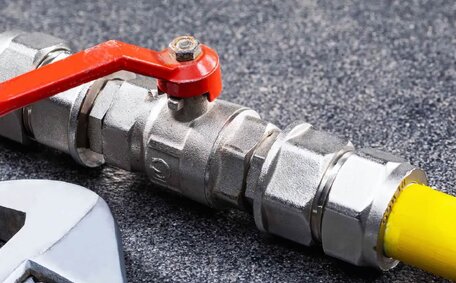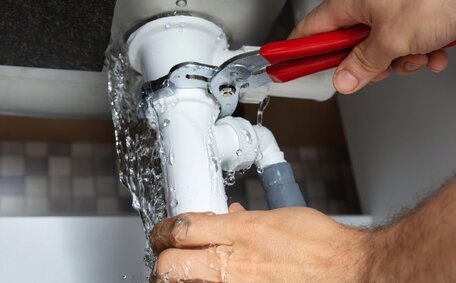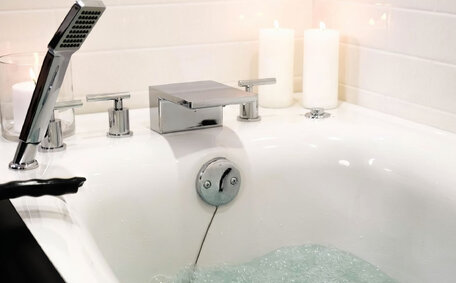What is Gas Line Pressure Testing and Why is it Important?
Gas line pressure testing verifies the integrity and safety of newly installed or repaired gas piping systems. This process entails pressurising lines with air or nitrogen to a typical excess of 3 psi over the system’s maximum operating level.
Adhering to the gas code when executing pressure tests is crucial, as gas leaks can lead to fires, explosions, and carbon monoxide poisoning. Consequently, local plumbing codes mandate testing prior to the connection of appliances to newly installed or altered gas pipes.
Pressure testing ensures the system is defect-free, confirming:
A slight pressure decrease during testing is acceptable, but a major decline could signal a leak. Leaks must be repaired and systems retested for integrity before usage.
While pressure testing is the responsibility of the gas fitter, homeowners should also be knowledgeable about gas safety fundamentals. If you’re having new gas appliances installed or lines modified, be sure to ask your technician about testing to protect your home and family.
Safety Precautions Before Conducting a Gas Pressure Test
Gas line pressure testing requires strict adherence to safety measures to prevent risks from air or nitrogen use.
First and foremost, pressure testing should only be performed by licenced and skilled gas fitters. Improper testing by unqualified individuals can endanger lives and breach regulations.
Before starting any test on a natural gas line, the technician should:
- Ensure all pressure gas lines leading to appliances are switched off
- Seal off the piping system with capped ends or plugs
- Check the piping and connections for defects
- Select an appropriate test pressure and suitable equipment
- Carefully pressurise the system according to specifications
Ensure the testing area is clear and secure to avoid interference. Technicians need to monitor pressure closely and act swiftly to depressurise should problems emerge.
By following these precautions under the guidance of qualified professionals, perform gas pressure tests on the line can be conducted safely.
Qualifications and Training Required to Test Gas Lines
Conducting gas line pressure testing demands technical competency and specialised training to ensure safety and compliance.
In Australia, gas fitters must complete a Certificate III in Gas Fitting from a Registered Training Organisation (RTO) and obtain a gas work licence from their state authority to legally conduct pressure gas line tests.
Mosman Plumbing’s certified gas fitters have over 10 years of experience and the necessary expertise to perform accurate pressure tests. Continuous training keeps our team skilled in up-to-date gas line pressure test procedures and best practices.
Specifically, our gas fitters are formally qualified in:
- Assessing systems before testing
- Setting up equipment like test gauges, manometers, and gas analysers
- Pressurising lines appropriately
- Monitoring and recording results
- Identifying and addressing issues
- Depressurising and clearing systems post-testing
With the highest pressure testing qualifications, Mosman Plumbing guarantees reliable, compliant assessments. Contact us for professional gas line testing backed by formal credentials.
Preparing to Conduct a Gas Line Pressure Test
Before pressure testing gas lines, technicians must know about and follow several key preparation steps to ensure safety and properly assess the system.
First, the appropriate permits and notifications must be secured from local authorities if installing new gas lines in Mosman. The site should also be prepared by clearing debris, marking underground utilities, and making the area accessible.
Disconnect appliances and isolated with individual shut-off valves. Ensure main system valves are closed, and endpoints of the line under test are capped or plugged.
The pipeline section must then be filled with air or nitrogen – never flammable gas mixtures. Required testing equipment like manometers, gauges and gas detectors should be set up per specifications.
With safety barriers, alerts, and active monitoring, pressurisation begins after double-checking connections and readiness for quick depressurisation in case of issues.
By meticulously following our thorough protocols, technicians ensure a safe, criteria-compliant testing process.
Methods of Gas Pressure Testing
There are two main methods used to pressure test gas lines - hydraulic testing and pneumatic testing.
Hydraulic Testing
Hydraulic testing involves charging the working gas pipelines with water or an approved liquid solution. The line is then pressurised to 1.5 times the system’s normal working pressure, or a minimum of 3 psig.
Liquids in testing help technicians easily locate leaks through evident pressure changes. It also delivers more accurate test readings. However, removing all liquid from the system after testing can be difficult.
Pneumatic Testing
Pneumatic testing uses nitrogen to raise air pressure within gas systems, bypassing the need for liquid solutions. The pipelines undergo pressurisation to the same levels - 1.5 times working pressure or at least 3 psig.
While gas mixtures make locating leaks challenging, they avoid liquid clearance issues. Pneumatic testing is generally favoured for extensive and intricate systems.
At Mosman Plumbing, our fully licenced technicians leverage industrial gauges to conduct either test method safely. We determine the most suitable approach based on the appliance, piping layout, and specs involved.
Regardless of the testing method, pipelines must hold pressure without exceeding permissible leakage thresholds. Get in touch with us to meticulously test gas line efficiency for both new or modified systems.
Step-by-Step Guide for Testing Gas Line Pressure
The procedure for testing natural gas pressure in pipelines is integral to confirm that new piping infrastructures are securely installed and pose no hazards. Although this guide is informative, for testing we strongly recommend consulting the expertise of qualified professionals such as Mosman Plumbing.
Follow these key steps to test pressure:
- Prepare the test area by clearing hazards, securing permits if needed, and posting warning signs. Shut off all appliances on the system and close main valves.
- Cap, plug or ball valve endpoints. Make sure to brace or support pipelines appropriately.
- Attach a pressure gauge and outlet valves to the test section, ensuring compatibility with the gas type if using air or nitrogen.
- Connect an air compressor or nitrogen cylinder to fill the line with test medium. Steer clear of using combustible fuel gas mixtures.
- Slowly increase system pressure to 3 psi above normal operating levels, or at minimum 3 psi gauge. Do not exceed max test pressures, and test pressure shall be less than the maximum allowable pressure.
- Monitor the gauges. An initial decrease is standard, as test pressure shall less than equilibrium levels as temperatures stabilise. If pressure plummets to below 3 psig, this typically signifies the presence of a leak.
- Maintain test pressure for at least 10 minutes. Carefully inspect all joints, valves and fittings for bubbles or larger leaks.
- Depressurize the system completely when testing concludes or issues arise. Check test equipment for faults if leaks are unidentified.
- Once passing pressure criteria, complete final purging and connections to appliances.
Adhering to these pressure testing steps, safety protocols and involving qualified professionals helps verify gas system integrity. Contact Mosman Plumbing if you need new lines installed or existing pipes tested.
Interpreting Test Results and Detecting Leaks
Carefully monitoring pressure gauge readings during testing is critical to interpret results accurately. Typically, an initial minor pressure drop is normal as temperatures stabilise. The system must then maintain pressure without further major declines for the duration of the test.
There are three main testing outcomes:
1.If pressure remains within acceptable limits with less than 10% loss over 10 minutes, the system passes the test. This indicates sound integrity with no leaks.
2. Pressure drops slowlyA steady, minor pressure drop suggests a small leak within the permissible boundaries. The rate of loss can determine the leakage rate for appropriate repairs.
3. Pressure drops rapidlyA sudden, swift fall in pressure marks a significant leak that demands immediate action for identification and rectification. All appliances should remain isolated until the issue is found and resolved.
During testing, technicians move through the pipes, joints, valves and fittings with leak detector solution or devices to pinpoint leakage locations if drops occur. Leakage sources are identified by bubble formation. After fixing a leak, retesting the lines is necessary before their operational use.
For professional new gas line testing and leak detection in Mosman, contact our licenced team at Mosman Plumbing today.
Troubleshooting Unexpected Pressure Drops
Unexpected rapid pressure drops during testing typically indicate a leakage in the system. Start troubleshooting by meticulously inspecting all connections, joints, valves, and fittings using leak detection solution.
Be attentive for hissing sounds, as they may also indicate leaks.
If the leak’s source remains elusive, disassemble and closely examine the gas lines for cracks or defective parts. Pressure testing equipment should also be examined for correct operation and calibration.
Any repairs or replacements needed should be completed according to specifications, then the lines must be purged and pressure tested again. The system needs to maintain pressure within acceptable limits before appliances can be connected.
Unexpected test failures are challenging but serve a critical role in identifying issues before starting the gas supply. Contact Mosman Plumbing if you need help addressing test leaks or failures.
Knowing When to Call a Professional
While DIY maintenance can address some basic plumbing issues, gas line pressure testing and leak detection should only be handled by qualified professionals. Contact Mosman Plumbing immediately if you experience any of the following:
- A possible gas leak suggested by a rotten egg smell or hissing noise
- A substantial, unexplained rise on the reading of your gas meter indicating an unusual amount gas usage
- Flames emanating from hot water systems and other gas appliances
- Unusual moisture around gas equipment
- Appliances igniting improperly, generating carbon monoxide or backdrafting
- Dirt, debris or corrosion on gas piping
- Damage to gas lines from digging, storms or pests
Our Mosman Plumbing gas fitters are certified and adept at conducting thorough assessments and deploying industrial calibrated equipment for testing. We determine proper test pressure based on pipe specifications, accurately monitor and log results and pinpoint leakage locations for repair.
For both new gas installations and checks on existing gas infrastructures, we manage all the required pressure assessments and offer documentation. If problems arise during testing or gas appliances exhibit issues, we troubleshoot and rectify them promptly.
Contact Mosman Plumbing on 1300 349 338 or [email protected] for urgent gas leak response and unparalleled pressure testing services.






